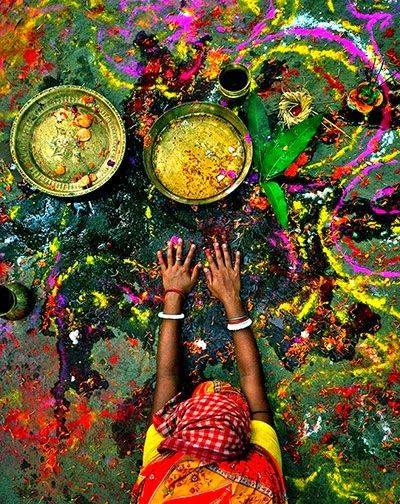by : Dr. Rama Rao Vadapalli V.B.
Trailingaswamy who lived a long life (1607-1887) has come be revered and worshipped as the Walking Siva of Varanasi. The great saint’s views on upasana as explained to his disciples are produced hereunder for the benefit of the readers.
Upaasana, committed, continuous, intense worship, is essential either to know or to reach God. If there is no such desire, there is no need for upaasana. Eeshwar does not desire anybody’s praise. He has compassion for everyone in equal measure. Upaasana, or ardent worship, is something like a machine, which attracts the pure power of God. If one wants to know god, the way in which god is to be found is itself called upaasana.
The culmination of sukha (comfort) is mahaasukha. No one thinks of that comfort, which fills all dark wildernesses with light, which lies at the bottom of the ocean filling the manas with total peace. No one knows how comfort feels without knowing grief. Only when a misdeed is done, one has to suffer tribulation. The reason why Eeshwar creates tribulation is only to give joy and comfort later. His wish and desire it is that man should hold on to the path of goodness and rectitude. The more it is mixed with lesser metals, the lesser would be the value of gold. The goldsmith goes on putting it in acid, beating it and melting it till the metal is purified. Creating hardship to the jeeva is part of God’s compassion. One should learn that both are the same. One should learn that instead of doing wrong and suffering in consequence, it is better not to do anything wrong. Why should one soil one’s self and then wash for cleanliness?
It is always necessary to worship Eeshwar. When that idea gets fixed in the mind, the first thing necessary would be aasan, a seat and a posture. What is necessary for the householders is explained here. An empty room where one could be alone is the best. Then, a reed mat, a carpet- like spread on that and a cloth on which to sit in meditation – these are necessary. The aspirant must sit facing north, his body, head and neck all in one line. He should sit cross-legged as instructed by his guru. Then he should close his eyes and keep his aim either on the tip of his nose or in the middle of the brow and with a calm frame of mind go on repeating the beejaksharas (mystic letters) or mantras (incantations) given to him by his guru. There is no distinction of caste for this. This should go on till complete control of the manas is achieved. It would take quite some time and there would be no use if the practice is discontinued in just a few days. Manas can be conquered by manas alone. Only strong power of the will can accomplish this. When once the manas is controlled things would become easy and easier slowly.
It is to be known that buddhi (mind, intellect), praanaa (life force), sareera (the body) ahamkaara (myness), the indriyas (senses) are different from aatma (the soul). Aatma is Eeshwar. It is pure, without shape or form, above birth-death-old age-disease. It is full of chaitanya (chit), joy, bodiless, perfect and full, permanent, replete with jnaana, living in all jeevas and all-transcending. Some do not believe in all this but that does not affect the world in any way.
 Like the sunrise, there is the dawning of jnaana in the evolved, first, in the form of vritti (existence). Then the darkness of ignorance is dispelled. Then aatma shines effulgently as the sun. As the tree that is bending appears in illusion as man, brahma padardha (divine essence) appears as jeeva. But when the illusion is dispelled, the real appearance of jeeva becomes manifest. Over and above that, the life affair of the jeeva would be resolved.
Like the sunrise, there is the dawning of jnaana in the evolved, first, in the form of vritti (existence). Then the darkness of ignorance is dispelled. Then aatma shines effulgently as the sun. As the tree that is bending appears in illusion as man, brahma padardha (divine essence) appears as jeeva. But when the illusion is dispelled, the real appearance of jeeva becomes manifest. Over and above that, the life affair of the jeeva would be resolved.
Man should always strive to reach heights with noble ideals, reaching an elevated state by contemplating on the ultimate ideal of the Supreme Being. The manas is highly unstable, inconstant and wavering. It is not easy remembering some great man’s ideal history. One has to lock the manas in a great seer, sage or ideal person. For this deep devotion is necessary. Without that none can become high ranking in the worship of Eeshwar.
A fully evolved one, a jnaani, would be able to see in his aatma through his inner eye the whole universe as having the same aatma. The whole of this world is aatma: there is nothing different from it. Whatever the potter makes of it, it is just the same clay. Without clay there is neither pot nor anything else earthen. The jnaani sees in his own aatma all things and beings.
Just as the wind blows everything and does not stick itself to anything, the jnaani, renouncing bodily and worldly comforts, becoming complete with the joy of the aatma, shines like a steady wick in the lamp. He thinks like a seer, a muni. When the base (upadhi) is gone, he enters into the all-pervading paramatma. The man who is an aatma jnaani (one knowing the soul) contemplating on the ever joy-filled Supreme Soul and shedding the earlier qualities of the base (upadhi) in him merges in the feeling of all pervading joy. Such a person is called jeevanmukta, the one liberated even while alive.
All beings, right from the ant to the highest of all creations, as per the variations between themselves, experience ananda, supreme joy. As there is ghee in milk, in everything there is the divine essence, brahma padardha. Even worldly affairs are not different from the Supreme Being. The jeeva is attracted to the senses and the sense-dependent feelings. If extricated from them, and burnt in the fire of jnaana, liberated from the impurities of the base, the jeevi shines resplendently. The one shining in every one as the base, as the rising sun dispels all darkness of ignorance. He who worships the allpervading, the one who is above the dualities like hot and cold, becomes eternal and all knowing.
Bhakti or devotion comes from dharma, jnaana from bhakti and mukti from jnana. Dharma is to offer manas and praana to Eeshwar. One who wants to attain moksha has to depend on Eeshwar for dharma. Only Brahma, the form of everlasting truth and joy, is the all-pervading. All deities are the aspects of that Supreme Being. The seeker of salvation, after performing worship as laid down, after attaining chittashuddhi becomes aatma jnaani, the one who knows the atma. Since they are all inimical to the way ofdharma, the six enemies and violence have to be given up. Kaama (desire), krodha (anger), lobha (niggardliness, avariciousness), moha (vicious attraction), mada (lust), maatsarya (avarice) are the arishad varga, the group of the six enemies. Only for those who give up these enemies deliberately, tattwa jnaana (knowledge of subtle philosophy) is accessible. After attaining tattwa jnaana, aatma saakshaatkaara (self-realization) is possible.
The prime objective of yoga saadhana is the restraint of the manas. Those who do not have any interest in bodily pleasures and physical comforts would be able to experience delectable bliss inwardly. One who holds his manas under control is more powerful than a king, or a warrior who wins a great battle. He is mahaapurusha, a great man. It is much easier to swim across the ocean than to hold the manas under firm control. Compassion is central to sadhana, practice. Self-love, ‘myness’ and egoism are the ways to damnation and naraka. The one who does not have ahamkaara (pride and ‘myness’), the one who treats both joy and grief as equal, the one who is ever satisfied and ever happy, the one who is forgiving, understanding, the one who dedicates himself totally to Gd, the one who does not have any desires, the one who is above sin and merit (paap and punya), such a one alone would be able to realize God. He looks upon honour and insult, friends and enemies, as equal.
Jnaana (wisdom and knowledge) alone leads to salvation. Without fire cooking is not be possible. Owing to ignorance (ajnaana) the pure aatma appears soiled. As the sun shines after the clouds disperse, aatma shines all by itself. The jeeva is more soiled than ignorance itself. Only jnaana makes a man pure. As the things seen in a dream appear true and become unreal in the wakeful state, owing to ignorance this world appears full of love and hate. When ignorance is gone, it dawns on one that all has been an illusion.
Eeshwar is formless – above sense perceptions and above qualities like bhakti and compassion. Mere discussions of bhakti do not lead anyone anywhere. There could be no worship of the formless (nirgunopaasana) without the worship of the one with form (sagunopaasana). For acquiring the knowledge of Eeshwara tatwa, thinking of one with a form would be a kind of a prop. By keeping things like mahima (grace), shakti (power) guna (quaility) in mind, if one worships, it becomes niraakaaropasana(worshipping of the one who is formless).
Upaasana could be of four kinds. The first is Eshwaropaasana, worship of Eeshwar. The second is the worship of the deity (devatopaasana). The third is the worship of powerful things like the sun and fire. The fourth is the worship of dharmiks, god-realized men. Worshipping the cow, the tree, the river, the mountain etc is also worship. People of different occupations like the blacksmith etc worship their tools. Lifeless things are assumed to havelife. The early man too used to do this. In other forms of upaasanathe lifeless are worshipped knowing full well that they are lifeless. This is called jadopaasana. (worship of lifeless things). Even this is not wrong, since some kind of inspiration could be derived by such worship.
We cannot see God. But when we understand His qualities, deeds, His power and His compassion, we realize that except by worshipping the one with form – saakaaropaasana – there is no use. When one understands the various modes of worship in Hindu dharma, its greatness and unique quality become transparent and obvious.
Real worship of Eeshwar is the one, which follows that specific scheme, which dispels the darkness of ignorance. What makes the chitta (heart-mind) pure, sublime, elevated and clean is upaasana. As long as chitta has even a trace of impurity, it cannot reflect Eeshwar. If one takes the aid of a deity for this purging, even that becomes upaasana.
While talking of the appearance or form of Eeshwar, the knowing-ones described Him in so many terms like niraakara, (shapeless) nirguna (without quality), anaadi (without beginning), and ultimately stated that He is invisible either for vaak, speech or manas (heart-mind-conscience). The various terms have to be clearly understood first. While construing that that which is not seen by the eye does not exist is not right. Air cannot be seen but it does have a form. So too are sabda (sound) and gandha (fragrance) etc.
It is not enough to repeat the word Bhagavan, Bhagavan: one should understand the meaning of Eeshwar before setting out on upaasana. What keeps the world going is the power of Eeshwar. All powers, which are there in this creation, are His powers, His energies. He, who could merge his own power and energy with that of Eeshwar, can comprehend Him. The unified sum of all the powers of all the worlds is Eeshwar. With this realized, He is known as one without form, without quality etc. When the saadhakaunderstands His deeds and power with a feeling of total devotion, he slowly attains perfection.
To know about the Creator, studying creation is necessary. To know the Destroyer, one has to understand the nature of deluge. The knowledge of the Destoyer is an aspect of the nature of Eeshwar. The effort to know with a determined heart and mind to know the one without beginning and the one who is the reason for everything is upasana. What is essential for upaasana is the determination to know God. Praying to God in a temple or on a riverbank is not upasana. The power of Kaali maa is endless. By upasanaendless benefits worldly and supraworldly come. But this is not upasana of Eeshwar. Only when something is adored in upasana it becomes Eeshwar upasana. Then only it signifies taking pride in Eshwar. But if that pride comes, the sadhaka falls in illusion. If we worship Kaali maa believing that She is another form of Eeshwar and get the feeling in the heart, we realize that that is also a form of Eeshwar and so, real. The upasaka should not think there is no fruit for that upaasana. Just by such a worship of the one with form, we can know the power (mahima) of the one without form or guna, the all-pervading.
Deity is the one who gives commensurate fruit for all actions. The deities have enthralled men with the idea of impermanent comfort (sukha). For that reason, man lies dumped in horrible darkness of ignorance about his relation with Eeshwar. As long as yearnings for impermanent comforts and desires are strong, the sadhaka cannot know of the eternal comfort that Eeshwar gives. Either to see or know god, desires have to be renounced in the first instance. Worship with desire is upaasana of the deity, without desire is worship of Eeshwar.
The sadhaka falls in the delusion that the statue made of clay, metal or stone is Eeshwar. If created statues should be real, the kingdom one gets in a dream should be real too.
We cannot see Eeshwar in His natural form. For that reason, out of ignorance we build statues of deities and by worshipping them, we have our desires fulfilled. Such statues should become forms that have powers of His entire power. But they cannot. They do not have the all-pervading form and power of Eeshwar.
Man’s own action (karma) gives auspicious and inauspicious fruit. Knowing that this power of action itself is deity, through brahma mentioned in Vedanta Shastra, nirguna purusha of Samkhya and the nirvilkapasamadhi of Yoga shastra, one can go up to his goal. Without brahma saakshaatkara, realization of brahma manifesting, everlasting comfort and the liberation consequent on nirvaana would not come. Through upaasana of deities, wealth and comforts would come. Because of that men are denied the great joy and comfort of samaadhi. With absolute concentration, desires are fulfilled. If one desires luxurious comforts, with the grace of such deities who give them, they can be obtained.
If one does not have desire in action, if such nishkaamakarma is performed, and if only gaining brahmajnana is the objective, the help of the formless, qualityless (nirgun) would be forthcoming. Worship without desire leads to brahmasaakshatkaara. When acts are without desire the acts themselves are worship of Eeshwar. With the desire of acquiring brahmajnaana, if worship is offered with no desire for luxury, comfort or affluence, it becomes the true worship of Eeshwar.
 Whatever we do is karma. Karma is of two kinds: sthoola karma (macro-action) and sookshma karma (micro- action). If we intend going somewhere and go there it is sthoola karma. For this some energy of the body has been spent in the movement of limbs. If the journey is made only in thought without actually going there, only some mental energy is spent. The seeds of action born in the form of the concentration of chitta stay fixed for a long time. The upaasana of a deity is upaasana procedure mentioned in the Vedas. Eeshwar is desire-less (nishkaama). So, by worship without desire alone can He be reached. If one has desires, hopes and expectations, Eeshwar cannot be reached. Hindus do not ask for anything of Eeshwar, except salvation, mukti. Eeshwar, the eternal and everlasting, does not know giving any thing else. By merely uttering the various qualities of Eeshwar and by reciting His various appellations, one does not get jnaana relating to Eeshwar.
Whatever we do is karma. Karma is of two kinds: sthoola karma (macro-action) and sookshma karma (micro- action). If we intend going somewhere and go there it is sthoola karma. For this some energy of the body has been spent in the movement of limbs. If the journey is made only in thought without actually going there, only some mental energy is spent. The seeds of action born in the form of the concentration of chitta stay fixed for a long time. The upaasana of a deity is upaasana procedure mentioned in the Vedas. Eeshwar is desire-less (nishkaama). So, by worship without desire alone can He be reached. If one has desires, hopes and expectations, Eeshwar cannot be reached. Hindus do not ask for anything of Eeshwar, except salvation, mukti. Eeshwar, the eternal and everlasting, does not know giving any thing else. By merely uttering the various qualities of Eeshwar and by reciting His various appellations, one does not get jnaana relating to Eeshwar.
Because of raaga (likes and attachments) and dwesha (hatred), auspicious and inauspicious or welfare yielding and harm yielding deeds are generated. Karma is the fundamental reason for the birth of the world. For this reason, avidya (ignorance) has to be shed. If somebody is harmed, the person who suffered the harm has to think as to who is really harmed. Considered this way, there is no hatred generated. After aatma leaves only the jada (lifeless) body is left behind. There is no chaitanya (consciousness) in it. It does not feel fire burning it or foxes eating it. There could be no avamaana (slight, dishonour or insult) for that.
The act of merging one’s own jeevaaatma (soul) with the aatma of the creation or the universe is called Yoga. A Yogi believes that he is in all living beings. When there is a crowd the noise coming out is not the individual voices of the people in the crowd. This is yoga. When so many voices and tones merge and issue forth in the same rhythm (laya), only a single sound issues forth. This tune is yoga. Those, who can thus experience the chaitanya of all, know what yoga is. That consciousness is the soul of the creation.
Through upaasana it dawns on the sadhaka that the relationship with the deity worshipped is soham, sah eva aham, He am I. The saadhaka knows who He is and who himself is. Then the relationship becomes intertwined, with hands and feet bound inextricably. As one’s own power of experiencing increases, human beings experience this relationship. True yoga lies in merging one’s own knowledge of his aatma with that of the universe. Trying adequately man can find in himself all the powers and all the actions that keep the world going. That is why man is known as a small brahmanda, a small universe.
– See more at: http://www.boloji.com/index.cfm?md=Content&sd=Articles&ArticleID=15289#sthash.U5KBVICx.dpuf











